|

|
|
Paramount,
1984 (2002 Col. Ed.), Color
Aspect ratio: 2.35:1/16x9 enh.
English Dolby Digital 5.1
English Dolby Stereo
French Dolby Stereo
1 Hr 45 min, Rated PG
Directed by Leonard Nimoy
Starring William Shatner, Leonard Nimoy, DeForest Kelley, James Doohan,
George Takei, Walter Koenig, Michelle Nichols, Merritt Butrick,
Christopher Lloyd.
|
|
0 |
5 |
|
Entertainment: |
 |
|
Video Quality: |
 |
|
Audio: |
 |
|
Photography: |
 |
|
MPEG Flags |
 |
|
Violence: |
Mild |
|
Sex: |
No |
|
Language: |
No |
|
A Bridge Picture
 Looking
at the interviews on the Director's Edition of "Star Trek II, The Wrath of
Khan", one notes a cynical William Shatner suggesting that Nimoy and
the producers intentionally set up a doorway to bring the Spock character back in a
later film, as if it was some conspiracy theory. Looking
at the interviews on the Director's Edition of "Star Trek II, The Wrath of
Khan", one notes a cynical William Shatner suggesting that Nimoy and
the producers intentionally set up a doorway to bring the Spock character back in a
later film, as if it was some conspiracy theory.
"Star Trek III" is for many just a bridge picture which only
serves to tidy up the dramatic stroke that punctuated the end of the
previous film. Closer examination though reveals a movie with sincere emotion, and as such, is an essential addition to any collection. This new Special
Collector's edition, exclusively on DVD, includes some good insights into its making.
Star
Trek III: The Search for Spock
 Kirk's
defeat of Khan and the creation of the Genesis planet are empty
victories. Spock is dead and McCoy is going insane. But Sarek,
Spock's father, provides a revelation: McCoy is harboring Spock's living
essence. Kirk attempts to help his friend by stealing the U.S.S.
Enterprise and defying Starfleet. But the Klingons race to meet Kirk
in a deadly rendezvous. Kirk's
defeat of Khan and the creation of the Genesis planet are empty
victories. Spock is dead and McCoy is going insane. But Sarek,
Spock's father, provides a revelation: McCoy is harboring Spock's living
essence. Kirk attempts to help his friend by stealing the U.S.S.
Enterprise and defying Starfleet. But the Klingons race to meet Kirk
in a deadly rendezvous.
In his script for "Star Trek II", Harve Bennett cultivated what he felt was the "core" of the show:
the Kirk-Spock-Bones relationship. With a mandate to bring Spock back
in the next installment, in The Search for Spock, we see a more emotionally
oriented screen play. Perhaps the unfortunate element is the requisite action
oriented side story which feels somewhat tossed in. Known for his
comedic genius, the unlikely choice of Christopher Lloyd as the Klingon captain is
outright brilliant and saves that side of the story from cheese city.
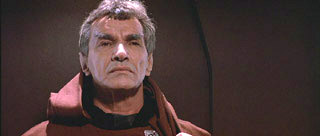 When the studios asked Leonard
Nimoy to once again don the pointed ears, he makes an interesting
request: to direct the film. At the time, it might have seemed
only as a good story for the press, but in retrospect Nimoy brought to the
project a feeling for classic acting, accounting for the film's shift towards
emotion. He went on to direct the next Star Trek film after which
William Shatner got his turn at the wheel with "Star Trek V, The Final
Frontier". When the studios asked Leonard
Nimoy to once again don the pointed ears, he makes an interesting
request: to direct the film. At the time, it might have seemed
only as a good story for the press, but in retrospect Nimoy brought to the
project a feeling for classic acting, accounting for the film's shift towards
emotion. He went on to direct the next Star Trek film after which
William Shatner got his turn at the wheel with "Star Trek V, The Final
Frontier".
ILM was again brought in for
much of the visual effects work. Drawing on their experience with the
Star Wars movies, in Search for Spock, effort was made to expand the
audience's sense of scale. Breaking from the microcosm of the
Enterprise, the Space Dock sequences represent a land mark in model work.
Extras
 Disc 1 features a commentary
track by director Leonard Nimoy, with Harve Bennett, Charles Correll, and
Robin Curtis.
Nimoy's voice is one of those like James Earl Jones: you are just
compelled to listen. Its an insightful commentary which reveals much
of the motivation which went into the film's making. Also available is a text-commentary by Star Trek Gurus Michael Okuda and
Denise Okuda (co-authors of The Star Trek Encyclopedia). Disc 1 features a commentary
track by director Leonard Nimoy, with Harve Bennett, Charles Correll, and
Robin Curtis.
Nimoy's voice is one of those like James Earl Jones: you are just
compelled to listen. Its an insightful commentary which reveals much
of the motivation which went into the film's making. Also available is a text-commentary by Star Trek Gurus Michael Okuda and
Denise Okuda (co-authors of The Star Trek Encyclopedia).
On disc 2 the we've got the
requisite making-of featurette, unique and fresh in that there are no on-the-set
segments. It is made entirely of separate interviews, done mainly with
Leonard Nimoy, William Shatner, and Harve Bennet. The amusing part is
the witty way the sound bites are spliced together. At one point I was
rolling on the floor laughing as it flipped between Nimoy saying one thing
and Shatner saying something completely contradictory.
The Archives contain a nice bag
full of original story boards and photos from both the set and the movie
itself. One gripe if I may: the story boards are grouped by
scene which is fine, but when flipping through them, one is taken back to
the story board menu at the end of each scene. It would be nice to be
able to flip through the whole set without having to go back to the menu a dozen
times.
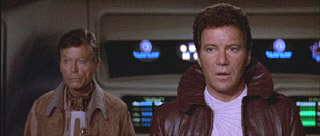 In
The Star Trek Universe there are three substantial
segments on the designs in the film. The first, Space Docks and
Birds of Prey deals with the space ships, the
space dock, and other visual effects work. The second segment,
Speaking Klingon, is a very
interesting segment with linguist Marc Okrand who walks us through the process of
inventing the Klingon language. The third piece, Klingon and Vulcan
Costumes, covers the design of
clothing and costumes for much of the Star Trek universe. In
The Star Trek Universe there are three substantial
segments on the designs in the film. The first, Space Docks and
Birds of Prey deals with the space ships, the
space dock, and other visual effects work. The second segment,
Speaking Klingon, is a very
interesting segment with linguist Marc Okrand who walks us through the process of
inventing the Klingon language. The third piece, Klingon and Vulcan
Costumes, covers the design of
clothing and costumes for much of the Star Trek universe.
Finally, there is Teraforming
and the Prime Directive, a piece on
real world research being done on something similar to the Genesis process
featured in the film.
On the whole, the set has a good complement
of extras with a special note: as with Wrath of Khan Director's
Edition, all these extras are 16:9 enhanced. This is a huge step
in the right direction, and I hope everyone follows suit.
The Transfer
 The video master is the same as
the one used for the earlier DVD release of Search for Spock.
In 1999, a new 35mm interpositive was struck from the 35mm original negative
and transferred to a high definition D5 tape at Post Logic Studios by
colorist Sheri Eisenberg. Sheri used a 1994 pan and scan D1 transfer
that was supervised by Leonard Nimoy as a color reference. The D5 was
down-converted to a 16x9 NTSC digital Betacam master that was the source of
the compression stream for both releases, compressed and authored at DVCC. The video master is the same as
the one used for the earlier DVD release of Search for Spock.
In 1999, a new 35mm interpositive was struck from the 35mm original negative
and transferred to a high definition D5 tape at Post Logic Studios by
colorist Sheri Eisenberg. Sheri used a 1994 pan and scan D1 transfer
that was supervised by Leonard Nimoy as a color reference. The D5 was
down-converted to a 16x9 NTSC digital Betacam master that was the source of
the compression stream for both releases, compressed and authored at DVCC.
The overall video quality we regard as only par. Color is consistent
and has a nice natural feel that does not give away the age of the film.
Blacks and shadow detail are also good, the depths of space rendered with a
nice velvety feel. Unfortunately, there is a little too much edge
enhancement for comfort, the avoidable blemish visible even on smaller,
interlaced displays. There is also an abundance of video noise which
some may pass as film grain but with the vertical filtering typical of all
DVDs, there is hardly enough resolution to resolve true grain.
On the whole, this is a nicely detailed
transfer with obvious care and attention paid by the colorist but some
neglect on the part of the encoder.
MPEG Flags
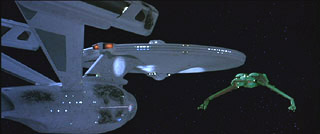 The following information only affects progressive scan display of the movie and has
no impact on interlaced displays. For an explanation of MPEG Picture
Flags, please see the section "How
the information is stored on disc" in Part
5 of our DVD Player Benchmark. The following information only affects progressive scan display of the movie and has
no impact on interlaced displays. For an explanation of MPEG Picture
Flags, please see the section "How
the information is stored on disc" in Part
5 of our DVD Player Benchmark.
While not perfect (we have
seen none so far that are), in its favor there was not a single instance of video
flagging on this encoding of the film, and the chapter breaks are all clean.
We did find 41 instances of
3-3 progressive and 38 instances of 2-2 progressive, all of which lasted for
only 2 MPEG PICs (4-6 video fields).
The Audio
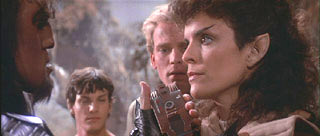 The 5.1 soundtrack was made
from an original 35mm six-track magnetic soundtrack master for the 70mm
release of the film (1984). That source track followed the
"classic" 70mm 6-track layout of five screen channels and one
surround. Great care and precision by mixer Ted Hall at Pacific Ocean
Post Sound transformed that layout to the more contemporary 5.1 sound space
of three screen channels, two surrounds, and one LFE. What we are
hearing therefore is very close to what was heard by audiences at 70mm road
show engagements almost two decades ago as opposed to it being someone's all
out reinterpretation of the piece. The 5.1 soundtrack was made
from an original 35mm six-track magnetic soundtrack master for the 70mm
release of the film (1984). That source track followed the
"classic" 70mm 6-track layout of five screen channels and one
surround. Great care and precision by mixer Ted Hall at Pacific Ocean
Post Sound transformed that layout to the more contemporary 5.1 sound space
of three screen channels, two surrounds, and one LFE. What we are
hearing therefore is very close to what was heard by audiences at 70mm road
show engagements almost two decades ago as opposed to it being someone's all
out reinterpretation of the piece.
While generally free of
distracting defects or distortion, the soundtrack has a curious schizophrenic
character as the spectral balance of the track often changes
dramatically with cuts within a single scene. That artistic point aside,
though sounding dated, dialogue intelligibility is excellent, and James
Horner's thematic score is spacious and dynamic. The surrounds are
used to full advantage as they embody the discreet omnipresent white noise
of the starship engines. The occasional split surround effect can be
witnessed accompanying a fly-by of one of the ships. The louder action
sequences are dynamic and punchy, free of mic preamp
clipping distortion.
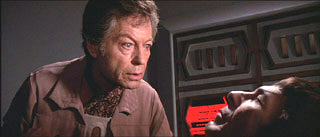 There is a little bit of hiss in the track,
no doubt an inherent character of the magnetic source track's age, but it is not too serious. There is a little bit of hiss in the track,
no doubt an inherent character of the magnetic source track's age, but it is not too serious.
Stay tuned for reviews of other
Star Trek movies as they are released in special Director's / Collector's Editions.
Terms
and Conditions of Use

|


 Looking
at the interviews on the Director's Edition of "Star Trek II, The Wrath of
Khan", one notes a cynical William Shatner suggesting that Nimoy and
the producers intentionally set up a doorway to bring the Spock character back in a
later film, as if it was some conspiracy theory.
Looking
at the interviews on the Director's Edition of "Star Trek II, The Wrath of
Khan", one notes a cynical William Shatner suggesting that Nimoy and
the producers intentionally set up a doorway to bring the Spock character back in a
later film, as if it was some conspiracy theory. Kirk's
defeat of Khan and the creation of the Genesis planet are empty
victories. Spock is dead and McCoy is going insane. But Sarek,
Spock's father, provides a revelation: McCoy is harboring Spock's living
essence. Kirk attempts to help his friend by stealing the U.S.S.
Enterprise and defying Starfleet. But the Klingons race to meet Kirk
in a deadly rendezvous.
Kirk's
defeat of Khan and the creation of the Genesis planet are empty
victories. Spock is dead and McCoy is going insane. But Sarek,
Spock's father, provides a revelation: McCoy is harboring Spock's living
essence. Kirk attempts to help his friend by stealing the U.S.S.
Enterprise and defying Starfleet. But the Klingons race to meet Kirk
in a deadly rendezvous. When the studios asked Leonard
Nimoy to once again don the pointed ears, he makes an interesting
request: to direct the film. At the time, it might have seemed
only as a good story for the press, but in retrospect Nimoy brought to the
project a feeling for classic acting, accounting for the film's shift towards
emotion. He went on to direct the next Star Trek film after which
William Shatner got his turn at the wheel with "Star Trek V, The Final
Frontier".
When the studios asked Leonard
Nimoy to once again don the pointed ears, he makes an interesting
request: to direct the film. At the time, it might have seemed
only as a good story for the press, but in retrospect Nimoy brought to the
project a feeling for classic acting, accounting for the film's shift towards
emotion. He went on to direct the next Star Trek film after which
William Shatner got his turn at the wheel with "Star Trek V, The Final
Frontier". Disc 1 features a commentary
track by director Leonard Nimoy, with Harve Bennett, Charles Correll, and
Robin Curtis.
Nimoy's voice is one of those like James Earl Jones: you are just
compelled to listen. Its an insightful commentary which reveals much
of the motivation which went into the film's making. Also available is a text-commentary by Star Trek Gurus Michael Okuda and
Denise Okuda (co-authors of The Star Trek Encyclopedia).
Disc 1 features a commentary
track by director Leonard Nimoy, with Harve Bennett, Charles Correll, and
Robin Curtis.
Nimoy's voice is one of those like James Earl Jones: you are just
compelled to listen. Its an insightful commentary which reveals much
of the motivation which went into the film's making. Also available is a text-commentary by Star Trek Gurus Michael Okuda and
Denise Okuda (co-authors of The Star Trek Encyclopedia). In
The Star Trek Universe there are three substantial
segments on the designs in the film. The first, Space Docks and
Birds of Prey deals with the space ships, the
space dock, and other visual effects work. The second segment,
Speaking Klingon, is a very
interesting segment with linguist Marc Okrand who walks us through the process of
inventing the Klingon language. The third piece, Klingon and Vulcan
Costumes, covers the design of
clothing and costumes for much of the Star Trek universe.
In
The Star Trek Universe there are three substantial
segments on the designs in the film. The first, Space Docks and
Birds of Prey deals with the space ships, the
space dock, and other visual effects work. The second segment,
Speaking Klingon, is a very
interesting segment with linguist Marc Okrand who walks us through the process of
inventing the Klingon language. The third piece, Klingon and Vulcan
Costumes, covers the design of
clothing and costumes for much of the Star Trek universe. The video master is the same as
the one used for the earlier DVD release of Search for Spock.
In 1999, a new 35mm interpositive was struck from the 35mm original negative
and transferred to a high definition D5 tape at Post Logic Studios by
colorist Sheri Eisenberg. Sheri used a 1994 pan and scan D1 transfer
that was supervised by Leonard Nimoy as a color reference. The D5 was
down-converted to a 16x9 NTSC digital Betacam master that was the source of
the compression stream for both releases, compressed and authored at DVCC.
The video master is the same as
the one used for the earlier DVD release of Search for Spock.
In 1999, a new 35mm interpositive was struck from the 35mm original negative
and transferred to a high definition D5 tape at Post Logic Studios by
colorist Sheri Eisenberg. Sheri used a 1994 pan and scan D1 transfer
that was supervised by Leonard Nimoy as a color reference. The D5 was
down-converted to a 16x9 NTSC digital Betacam master that was the source of
the compression stream for both releases, compressed and authored at DVCC. The following information only affects progressive scan display of the movie and has
no impact on interlaced displays. For an explanation of MPEG Picture
Flags, please see the section "How
the information is stored on disc" in
The following information only affects progressive scan display of the movie and has
no impact on interlaced displays. For an explanation of MPEG Picture
Flags, please see the section "How
the information is stored on disc" in  The 5.1 soundtrack was made
from an original 35mm six-track magnetic soundtrack master for the 70mm
release of the film (1984). That source track followed the
"classic" 70mm 6-track layout of five screen channels and one
surround. Great care and precision by mixer Ted Hall at Pacific Ocean
Post Sound transformed that layout to the more contemporary 5.1 sound space
of three screen channels, two surrounds, and one LFE. What we are
hearing therefore is very close to what was heard by audiences at 70mm road
show engagements almost two decades ago as opposed to it being someone's all
out reinterpretation of the piece.
The 5.1 soundtrack was made
from an original 35mm six-track magnetic soundtrack master for the 70mm
release of the film (1984). That source track followed the
"classic" 70mm 6-track layout of five screen channels and one
surround. Great care and precision by mixer Ted Hall at Pacific Ocean
Post Sound transformed that layout to the more contemporary 5.1 sound space
of three screen channels, two surrounds, and one LFE. What we are
hearing therefore is very close to what was heard by audiences at 70mm road
show engagements almost two decades ago as opposed to it being someone's all
out reinterpretation of the piece. There is a little bit of hiss in the track,
no doubt an inherent character of the magnetic source track's age, but it is not too serious.
There is a little bit of hiss in the track,
no doubt an inherent character of the magnetic source track's age, but it is not too serious.

